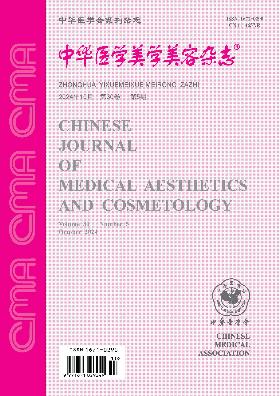他克莫司治疗白癜风对局部趋化因子分泌的影响
引用次数: 0
摘要
目的分析白癜风患者局部趋化因子的异常情况,探讨他克莫司对白癜风患者角化细胞分泌趋化因子的影响。方法收集50例白癜风患者的水疱液,包括病变区和正常区。利用Luminex分析白癜风患者局部趋化因子浓度,确定趋化因子是否与白癜风密切相关。Western blot分析他克莫司对HaCaT细胞趋化因子分泌的影响。结果通过对白癜风白斑部位水疱液的Luminex分析,发现CXCL9、CXCL10在白癜风白斑部位的表达明显增高,与正常部位水疱液比较,差异有统计学意义(P<0.01)。IFN-γ显著刺激角质形成细胞系HaCat表达CXCL9和CXCL10。他克莫司20 mg预处理HaCaT细胞后,CXCL9和CXCL10的表达与空白对照相比显著降低(P<0.01)。结论白癜风患者白斑趋化因子CXCL9和CXCL10高表达。他克莫司可显著降低应激状态下角质形成细胞中CXCL9和CXCL10的表达,因此对白癜风具有治疗作用。关键词:白癜风;他克莫司;趋化因子CXCL9;趋化因子CXCL10;HaCaT细胞本文章由计算机程序翻译,如有差异,请以英文原文为准。
Effects of tacrolimus in treating vitiligo on the secretion of local chemokine
Objective
To analyze the abnormalities of local chemokines in patients with vitiligo and to explore the effect of tacrolimus on the secretion of chemokines in keratinocytes.
Methods
Blister fluids of 50 patients with vitiligo were collected, including lesion areas and normal areas. Luminex was used to analyze the concentration of local chemokines in patients with vitiligo to determine whether the chemokines were closely related to vitiligo. The effect of tacrolimus on chemokine secretion of was analyzed by Western blot in HaCaT cells.
Results
By Luminex analysis of blister fluid, it was found that CXCL9 and CXCL10 were significantly higher in the leukoplakia of vitiligo, and there was a significant difference, compared with the blister fluid in the normal site (P<0.01). IFN-γ significantly stimulated the keratinocyte cell line HaCat to express CXCL9 and CXCL10. After pretreatment of HaCaT cells with 20 mg tacrolimus, the expression of CXCL9 and CXCL10 was significantly decreased, compared with the blank control (P<0.01).
Conclusions
The leukoplakia chemokines CXCL9 and CXCL10 are highly expressed in vitiligo patients. The tacrolimus can significantly reduce the expression of CXCL9 and CXCL10 in keratinocytes under stress, and it therefore plays a therapeutic role in vitiligo.
Key words:
Vitiligo; Tacrolimus; Chemokine CXCL9; Chemokine CXCL10; HaCaT cells
求助全文
通过发布文献求助,成功后即可免费获取论文全文。
去求助
来源期刊
自引率
0.00%
发文量
4641
期刊介绍:
"Chinese Journal of Medical Aesthetics and Cosmetology" is a high-end academic journal focusing on the basic theoretical research and clinical application of medical aesthetics and cosmetology. In March 2002, it was included in the statistical source journals of Chinese scientific and technological papers of the Ministry of Science and Technology, and has been included in the full-text retrieval system of "China Journal Network", "Chinese Academic Journals (CD-ROM Edition)" and "China Academic Journals Comprehensive Evaluation Database". Publishes research and applications in cosmetic surgery, cosmetic dermatology, cosmetic dentistry, cosmetic internal medicine, physical cosmetology, drug cosmetology, traditional Chinese medicine cosmetology and beauty care. Columns include: clinical treatises, experimental research, medical aesthetics, experience summaries, case reports, technological innovations, reviews, lectures, etc.

 求助内容:
求助内容: 应助结果提醒方式:
应助结果提醒方式:


